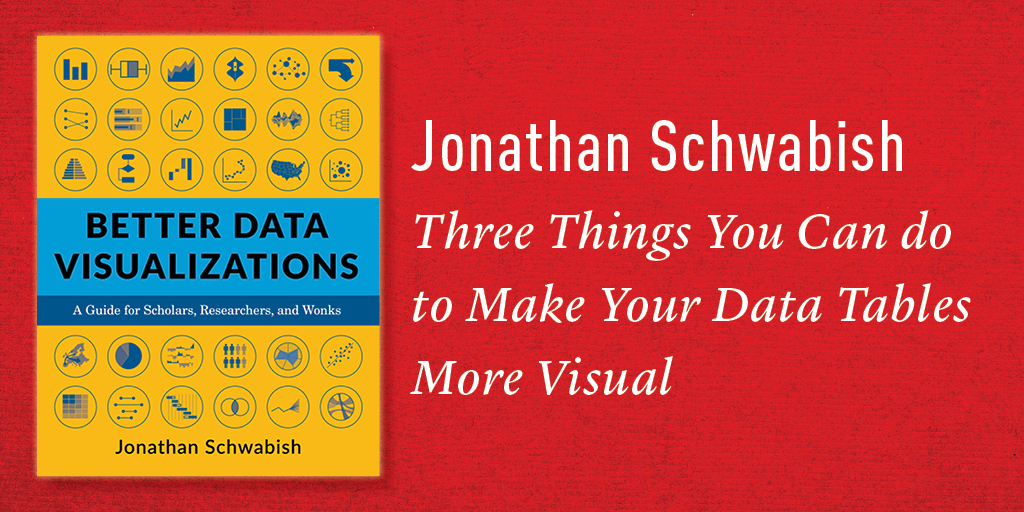Three Things You Can do to Make Your Data Tables More Visual
By Jonathan Schwabish

Tables are different from graphs and charts. Charts are meant to present a quick, visual representation of data. But tables are drill-downs, an outlay of all the data down to their exact values or estimates. Tables are not always the right choice. If you have too much data, they look cluttered. But a well-designed table can help your reader find specific numbers and discover patterns and outliers.
There are three ways to make your tables into better visualizations.
First, follow some basic principles for clarity and simplicity in your table design. Separate headers and footers from the body of the table by using boldface or separating lines. Align numbers along the comma or decimal and avoid using heavy gridlines or too many of gridlines. Consider using the appropriate level of precision—not every number needs four decimal points. And remove repetitive symbols like percentage and dollar signs; instead, put them in the subtitle or in the front row only.
Just following these first basic steps can help move a table from the version on the left to the version on the right:
Now that your table is stripped down to only what is essential, you can start adding elements back in strategically. Use colors or bolding to highlight outlier values or important trends to draw your reader’s eye to the important takeaways. Guiding your reader to the important numbers lets them answer their own questions about the data and better understand your argument. In these tables, for example, I highlight the few occurrences of negative values with colored text or cells.
Third, use other graph types within the table itself to simplify the table and make important values more obvious. Consider this nearly incomprehensible table from the US Department of Agriculture. It shows the number of people who participate in the Food Distribution Programs on Indian Reservations. The data covers participation estimates for twenty-four states over fiscal years 2013 through 2016 and preliminary estimates for fiscal year 2017. Note the very dark, thick gridlines, which clutter the table and make it difficult to read.
We can fix this.
Instead of just including all of the numbers, let’s add some small graphs or icons to make the table more visual. Here are three ways we can make this table easier to read and navigate.
One way is to convert it to a heatmap. Heatmaps use colors and color saturations to represent data values. Simply put, a heatmap is a table with color-coded cells. They are often used to visualize high frequency data or when seeing general patterns is more important than exact values. This is what the table looks like if we redesign it into a heatmap in which lighter shades encode smaller values and darker shades encode larger values.
Or we could use small bar charts or icons to illustrate a series. Quickly examining the original table, it’s tough to tell by how much program participation in Oklahoma exceeds the rest of the states. But if we add a small bar chart, the magnitude becomes much clearer. Or we could add an icon to mark increases or decreases over the entire period. The table on the right does so by including an upward or downward triangle to the end of each row.
One last option is to add sparklines. Sparklines are small line charts that are typically used in data-rich tables, often at the end of a row or column. The purpose of sparklines is not necessarily to help the reader find specific values but instead to show general patterns and trends. Here, the sparklines show all five years of data, which allows us to omit three columns of numbers, lightening and simplifying the table. This approach lets us show the full time series in the sparklines while just showing the two endpoints in the table cells.
For anyone who wants to communicate their work quickly and accurately, presentation matters. Effective tables are well organized, reduce clutter, focus the reader’s attention on the important points, and often integrate visual components.
Jonathan Schwabish is an economist and writer, teacher, and creator of policy-relevant data visualizations. He is the author of Better Data Visualizations: A Guide for Scholars, Researchers, and Wonks and Better Presentations: A Guide for Scholars, Researchers, and Wonks.














